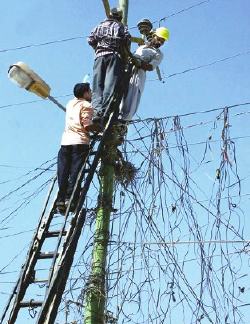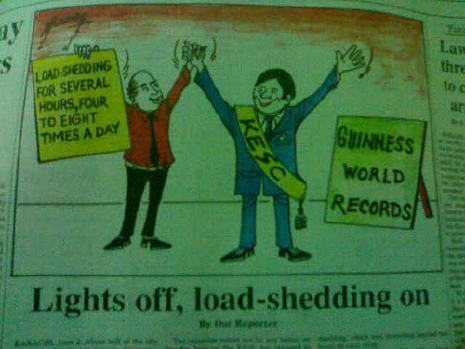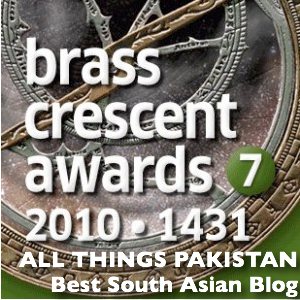Curtain Raiser: A friend of mine came up with a very creative motto for KESC during our school days at NED Karachi. It said:
zor ka jhatka..zara dheeray se lagay
It seems true now as KESC is giving lots of jolts to its customers. These jolts come slowly but linger longer than before. Power failures are more frequent now and the cost of electricity is highest ever.

Why this Post? Living abroad the ideas for a Pakistani blog mostly come through electronic news media. There is however, an unconventional source also. And that source is talking to one’s family in Pakistan. The idea for this post comes from this second source. For the past many months whenever I call home, one news always reaches up to my ears and that is ‘beta bijli buhat jaati hai’ (son, the electricity fails a lot). Finally I’ve decided to do something about it. That is, I am going to write about it.
KESC and WAPDA Jurisdictions. The elctricity supply business in Pakistan is under a sort of monopoly of two companies. For Karachi city and adjoining areas of Sindh and Balochistan, it is under Karachi Electric Supply Corporation (KESC). For rest of the Pakistan it falls under Water and Power Development Authority (WAPDA). Both companies operate their own networks and they are also interconnected to eachother at two points. One is the Jamshoro – BinQasim link in East of Karachi and other is HUBCO-KESC link in West of Karachi. Both companies can provide power to eachother through these links.
Karachi Electric Supply Corporation (KESC) was incorporated on September 13, 1913 and thus it will complete 94 years of its existence this year. At least up until 1993, both KESC and WAPDA had a power generation in excess of their demand [source 1 below]. Eventhough electricity supply has never been a sure thing in Pakistan, it had never failed so miserably as its been happening since 2006.
Before I delve further let me quickly give a brief introduction of a few technical terms
Generation: It means the quantitiy of elecricity generated. It is measured in Mega Watts (MW).
Transmission: Power Stations are usually located outside the population centers and electricity is transported from there to cities at a very high voltage. This long distance transport of electricity at high voltage is called ‘Transmission’. The units of measurement are kilo volts (KV). For Karachi the transmission is done at 220 kV, 132 kV and some circuits of 66 kV. Just for reference I also want to mention that highest transmission voltage in Pakistan is 500 KV done on a WAPDA line than runs all the way from HUBCO located at Arabian Sea coast at Sindh-Baluchistan border to Tarbela (NWFP).
Distribution: Once the electricity reaches population centers, it is distributed to substations and ‘Pole Mounted Transformers’ (PMT)s at lower (and safer) voltages. Units of measurements are kilo volts (kV). For Karachi City the distrbution voltage is 11 kV. There is 3800 km long underground cables of 11 kV as well as 2000 km of overhead wires of 11 KV in the city.
Grid Stations: Grid Stations are used to step down transmission voltage to distribution voltage. Karachi has 51 Grid Stations in its network. Grid stations supply 11 KV voltage to Substations.
From Substations the output voltage is usually 440V which is then further stepped down to 220V at more than 8000 ‘Pole Mounted Transformers’ (PMT)s located in the city for delivery to consumer homes. There are more than 10000 km of wires carrying 440V supply in the city.
As briefly mentioned above, up until 1993 both KESC and WAPDA had excess Power. KESC had an installed capacity of 1738 MW with the peak demand of 1280 MW. WAPDA had an installed capacity of 9800 MW with peak demand around 8000 MW. Believe it or not there were even talks of exporting excess power to India then.
Going thorugh daily news for the past many months I can safely say that KESC system now lies in shambles. Transmission is probably the only piece that has stayed out of negative news otherwise from Poor management to Lower generation to total breakdown of distribution is a norm now. Add to this a news item of Aug 6 that Karachi consumers will now pay extra 29 paisas/unit on their bill. This situation reminds me of a sher which I had first read in a Mushtaq Ahmed Yousufi‘s book. It goes like this:
chumkaaray, chumkaar kay maaray
maaray, maar ke phir chumkaaray
Generation Problems: Let us first take a look at what is plaguing KESC at Generation Level. As of 2007, KESC owns 1756 MW of generation capacity which had overtime been degraded to 1336 MW. After some recent rehabilitation projects, the company has managed to enhance its generation levels to 1534 MW (source: Daily News, Aug 6, 2007). The approximate demand for power in the city is atleast 2300 MW. To meet the supply-demand gap, KESC purchases power from WAPDA, Independent Power Producers (IPP)s and KANUPP. Whenever any of these outside entities fail to provide power OR there is a breakdown in KESC’s own installed generation base, they have to resort to load shedding.
KESC currently buys 250 MW power from the Independent Power Producers (IPP)s located in Karachi, namely Tapal Energy, Gul Ahmed Energy and Anoud Power Generation Ltd. KESC also buys 40-50 MW power from PAEC’s Karachi Nuclear Power Plant (KANUPP) (source: Daily news, Aug 6, 2007) and Pakistan Steel Mills , which provides 20 MW electricity. In addition to this Government of Pakistan has recently instructed WAPDA to sell up to 800 MW to KESC.
There has been no recent increase in the generation capacity in KESC region of supply. The last power plant to go online in Karachi area was HUBCO which falls under WAPDA and it is already more than 10 years old. There is a power and desalination plant being worked on in Defence Phase VIII which will be the first one to go on KESC network by the end of 2007.
KESC does have plans to enhance is capacity in two phases. First is going to be a 220 MW extension at Korangi Thermal Power Station (KTPS) and then in phase II there will be an additional 575 MW capacity installed at Bin Qasim Thermal Power Station (BQTPS). KESC claims to partly put the first phase in operation by 2008.
Geographic Location of KESC Power Plants: Most of the generation capacity of KESC is located in east of the city. This adds an unnecessary transmission cost in moving this power to north, west and south of the city.
Distribution Problems: Now let us come to KESC’s distribution woes. The distribution network is not only below demand but there is a huge factor of power theft also. This theft happens in three ways:
1. KESC clients who already have connections, bypass the electricity meters. Few years ago KESC was being run by the Army and even they couldn’t stop the power theft inspite of moving electricity meters of most of the city out on the streets. This was done to ensure the meters are not tempered with.
2. Industrial clients who are billed according to a sanctioned load use bigger grips to get more power
3. People use kundas (hooks) on distribution lines.
 This photo shows tens of illegal electricity connections made on a single pole by (kundas) hooks in Lines Area, Karachi. Photo is courtesy of daily Jang, Karachi.
This photo shows tens of illegal electricity connections made on a single pole by (kundas) hooks in Lines Area, Karachi. Photo is courtesy of daily Jang, Karachi.
In a typial utility company, T&D (Transmission and Distribution) losses are factored at 10% of the total generation capacity. In 2004 it was told on National Assembly floor that T&D losses alone amount to 38% on KESC. This is the sign of a truly inefficient distribution network as well as massive power theft on KESC’s network.
Management Issues: One more angle of KESC’s inefficiency is its management. The company was sold to a private firm Messers KES Power and Others who took control of the company on November 29, 2005 . The new management employed Siemens Pakistan Engineering Limited as the Operations and Management (O&M) Contractor . This includes generation, transmission, distribution, maintenance etc. KESC of old days was highly unionized and the labor is naturally wary of working with the new employers.
Situation in Summer of 2007: The start of summer in 2007 saw many instances of Power riots in Karachi. This phenomena though not unheard of before was not so commonplace as it felt in 2007.
Photo to the left is a scene of Power riots that broke out in Karachi on June 10, 2007.
The situation in 2007 has become so bad that on March 10, 2007 KESC had to run a public assurance to go through just ONE DAY without power loss. See that news and its reactions here.
To conclude we can say there is a strong need for setting up of more power stations in geographically varied spots (not just east of Karachi) as well as stopping of power theft. These should be the first steps in improving KESC’s performance. KESC and IPPs should also think of using cogeneration for smaller customers where-ever electrical load accompanies a thermal load. The combined efficiency of cogeneration units is upto 80%.
References:
1. ‘Energy Crisis in Pakistan’ by Ali Hasan Cemendtaur
2. KESC ‘s official web site
3. Metroblogging Karachi
4. Some photos are taken from flickr.com. Clicking on those photos will take you to their parent website.
ATP’s Related Posts:
1. The Daredevil Electricians of Pakistan
2. KESC, Karachi and Power Outages



















































KESC labor union is creating resistence for taking of
vss scheme. and all labor are very said because they want to left kesc because their finencially position have very down in strike .i want to say in clear word Labor union have criminal and terrorist activities all kesc system have disturb by labor union .kesc officers performs their duties on footpath and labor union is firing on officers and beat on footpath because they serve
of consumers and drive of kesc system.
i want to ask my pakistani brothers Kesc Management is on Right or Labor union is on Right with regards.
KESC is Dishonest itself.
very few people are aware that they can repreive by going to Electric Inspector in NEPRA and filling a complaint against KESC .
If there is a detection bill , KESC is not allowed to charge more than three months in difference and maximum six months if they get permision from their CEO. this is according to NEPRA rule/code 9-1-c .
If the meter is burnt out by water seepage or natural acts of GOD, KESC is responsible to pay for that not the consumer.
At the moment KESC is charging the consumer for this.
KESC is also charging 18 months of difference in billing for detection bills. This is dishonest and thievery by KESC.
KESC is charging
so for as i think this is a good effort which i have just read by as a matter of fact i want to add something in ur information n that is critisisms is a bit easy as compared to look at the facts and the statistical information provided by KESC. but we know really well that hydroelectric power stations are the only source of the electricity of pakistan. we must consider the water shortage of pakistan. neither i have connections with any political party nor i m favouring someone. but we will have to give some time to the new political management of pakistan. it is also a fact that there are some management problems in WAPDA and the picture u have presented is a prove of this. but as paksiatan is a third world country so we will have to be patient rather than exploring the problems of pakistan internationally. please stop critising and secure the moral of this country.
Hi,
I think the problem is also with our lifestyle. we live in a 3rd world country, but we consume electricity more than people living in developed countries.
one of the reason in my opinion is the use of Television. I remember in my childhoold, there was only PTV which usually start its transmission at 4:00 p, and would stop around 11:30 pm. ( 6 hours per day average )
now with all those private channels, ( approx 64) in most of the homes, Television is being used for more than 14-16 hours per day. ( start from 10:00 am in the morning to 1:00 am )
on average Television cosumes 0.80 kWH electricity in 1 hour
21″ tube TV consumes 70 watts
70 x 12 hours = 840 / 1000 = .84 kWH (kilo watt hour )
so if you use your Television for 12 hours
0.80 x 12 hours = 9.6 kWH per day !!
as compare to the old days on average we are using more evergy to watch TV, that means approx 5 kWH more energy per day.
an estimate what do you think ow many TVs are in karachi city ( a population of 1,50,00,000 ) now imagine 15 Lacks TVs in karachi
15,00,000 TV x 5 kWH = 75,00,000 ( 75 Lacks kWH )
which is 7.5 MW
so in terms of TVs only we are spending 7.5 MW !!
now you can calcualte for
VCRs, DVD Players, Personal Computers etc etc.
and the most important thing is about our lifestyle in karachi. we stay up around until 1:00 as average, if we goto bed early, lets say 11:00 pm, we will be saving a lot of energy.
and also a lot of medical expenses. most of the people in karachi city develop diseases like, blood pressure, stomach problems and other so many problmes due to the lack of sleep.
I think we need to change our lifestyle.
we are the culprits.
people of a poor country, try to adopt a lifestyle of rich countries.
Pakistan power cuts, another ENRON?
http://FixyaExperts.wordpress.com, http://FixyaExperts.blogspot.com
by Parveez Syed